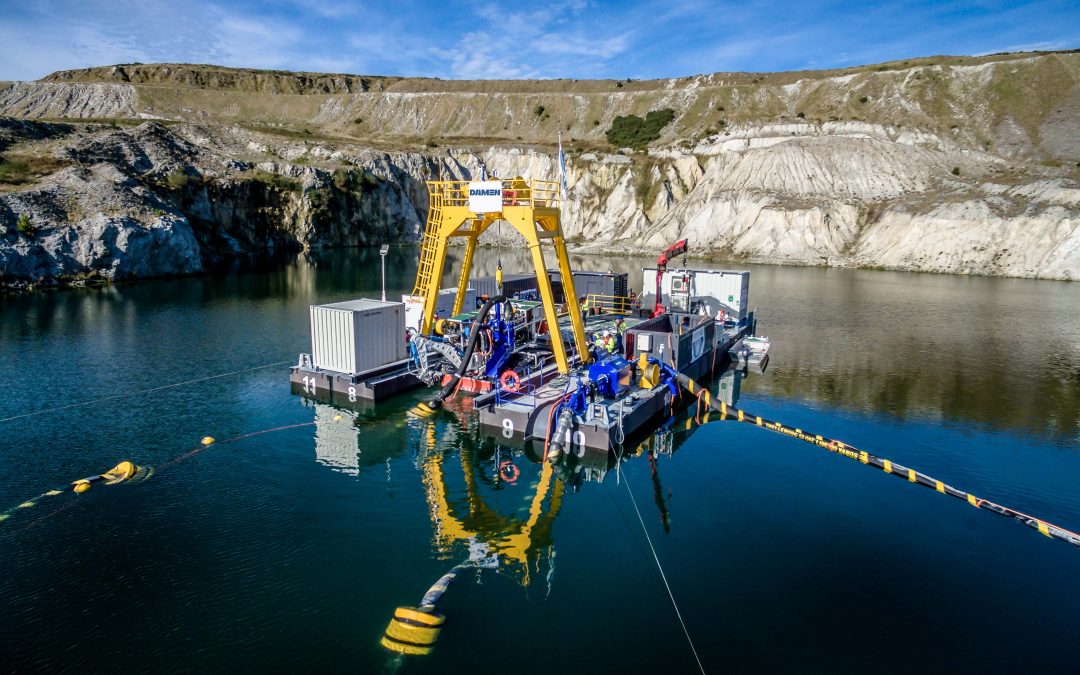¡VAMOS! is an EU Horizon 2020 research and development project evaluating innovative methods to exploit and rehabilitate abandoned mineral sites. Last month the ¡VAMOS! team carried out pioneering field trials for a new, novel mining technique at an Imerys Minerals Ltd flooded quarry in Devon. Imerys Minerals Ltd is a member of the Cornwall Mining Alliance (CMA), along with Marine Minerals Limited and FUGRO, who are ¡VAMOS! project partners.
The ¡VAMOS! project aims to enable access to high grade EU reserves of deeper seated minerals by providing a new Safe, Clean and Low Visibility Mining Technique and will prove the Environmental and Economic Viability of extracting currently unreachable mineral deposits, thus encouraging investment and helping to safeguard the EU access to strategically important minerals. The ¡VAMOS! mining technique will enable: Re-opening abandoned mines; Extensions of open cut mines which are limited by stripping ratio, hydrological or geotechnical problems; and opening of new mines with limited environmental impacts in the EU.
The ¡VAMOS! team has visited several abandoned mine sites over the last 2 years, investigating suitability for field testing. Following a careful selection process, eventually two mine sites were selected, in which the novel mining technique will be tried out. The first one is at Whitehill Yeo pit at Lee Moor, Devon. This site has kindly been made available by Imerys Minerals Ltd, a world leader in mineral-based industrial products.
The pit is a flooded kaolin mine, which ceased operation in 2008. The kaolin, also known as China clay, is a decomposed form of granite and is used in countless industrial applications. The infrastructure present at the site and nearby facilities made it the first choice for ¡VAMOS!
The site had been out of service for a significant period of time, so a bathymetric survey was carried out to examine the submerged environment and confirm suitability. Preparatory work at Lee Moor started in June, in tandem with the development of software and communications. A safe working area was established at the site and a slurry depot created to hold the pumped up underwater mined material.
A Launch & Recovery Vessel developed by Damen Dredging Equipment (Netherlands) was assembled on site in August and the Mining Vehicle (MV), built at Soil Machine Dynamics’ facilities in Newcastle Upon Tyne (UK), was transported to Devon in early autumn. Sophisticated, integrated Positioning, Navigation and Awareness systems are essential to the successful performance of the MV.
A visitors’ demonstration during the field trial last month was attended by 29 visitors from the project team and advisory board, as well as interested parties from across the sector, including members of the Cornwall Mining Alliance. Visitors were fortunate to be able to inspect ‘EVA’ (the Exploration VAMOS AUV) prior to launch. EVA is an automated underwater vehicle that is being used to assist in precise positioning, navigation and situational awareness of the Mining Vehicle.
Tours were provided of the Control Unit and Data Centre, where visitors were shown the impressive virtual reality system, linked to real-time operational data. Real-time data includes mineralogical grade control information, which is collected by a LIBS (a Laser Induced Breakdown Spectrometer). The LIBS can be used for a wide range of commonly mined minerals.
During the day, ¡VAMOS! demonstrated a highly successful integration of different systems to be applied in underwater mining and the project team went on to complete necessary tests at Lee Moor, to advance the project targets.
Members of the Cornwall Mining Alliance are keen to support research, innovation and development in the mining sector. If you would like to collaborate on a project, please get in touch with us.

